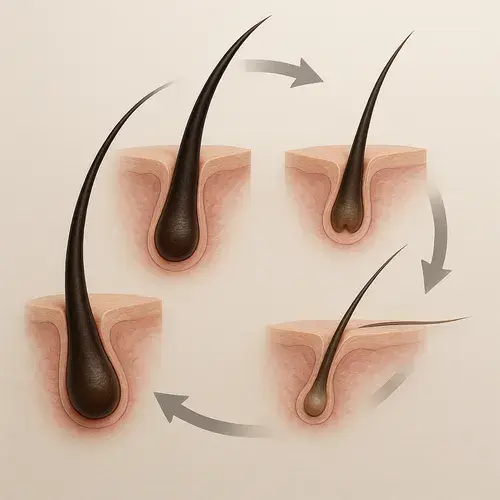Understanding the Hair Growth Cycle: A Comprehensive Guide
Discover the four key stages of the hair growth cycle—anagen, catagen, telogen, and exogen—and how factors like age and nutrition impact healthy hair growth and shedding.

Hair growth is a complex process that involves several stages, each with its own timeline and characteristics. The hair growth cycle is essential to understand because it helps us grasp why hair grows at different rates and how various factors can influence this process. In this article, we will delve into the four stages of the hair growth cycle: anagen, catagen, telogen, and exogen. The Anagen Phase: The Growth Phase The anagen phase is the longest stage of the hair growth cycle and can last anywhere from two to eight years for scalp hairs. During this phase, hair follicles are actively producing new cells, which leads to continuous hair growth. This phase is also known as the "growth phase" or "active phase. " The rate of hair growth during anagen varies but typically averages about half an inch per month, or around six inches per year. The Catagen Phase: Transition Phase The catagen phase is a brief transitional stage that lasts approximately one week. During this period, hair follicles begin to shrink and detach from the dermal papilla, which is the base of the hair follicle. This phase is crucial because it marks the end of the anagen phase and the beginning of the telogen phase. Although it's a short stage, it's essential for the overall cycle of hair growth. The Telogen Phase: Resting Phase The telogen phase is the resting phase of the hair growth cycle, lasting about three months. At this stage, old hairs enter a resting state and prepare to fall out. Approximately 10% to 15% of scalp hairs are in this phase at any given time. After about two to four weeks, these hairs will naturally shed and make way for new hair growth. The Exogen Phase: Shedding Phase The exogen phase is the final stage of the hair growth cycle, where old hairs are shed from the scalp. This phase is often referred to as the "shedding phase. " Although it might seem like a loss, it's actually a necessary step for new hair growth. Typically, a new hair is already growing in the follicle that previously housed the old hair, ensuring continuous hair growth. Factors Influencing Hair Growth Several factors can influence the hair growth cycle, including age, nutrition, and overall health. For example, as people age, the duration of the anagen phase tends to shorten, leading to thinner and shorter hair. Proper nutrition and a balanced diet rich in vitamins and minerals are crucial for maintaining healthy hair growth. Additionally, hormonal changes can affect the hair growth cycle, leading to conditions like alopecia areata, where excessive shedding occurs. Conclusion Understanding the hair growth cycle is essential for maintaining healthy hair. By knowing the different stages of hair growth—anagen, catagen, telogen, and exogen—you can better appreciate why hair grows at different rates and how various factors can influence this process. By taking steps to ensure proper nutrition and overall health, you can help ensure that your hair follows a healthy growth cycle.
Need Professional Consultation?
Our professional doctors will provide detailed hair and scalp analysis and develop personalized treatment plans.
Book Consultation Now